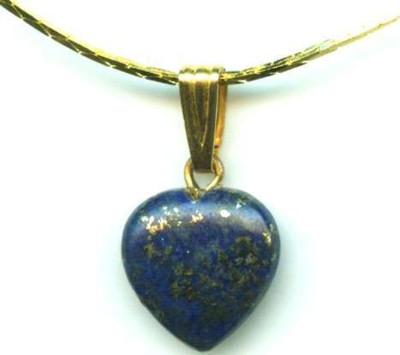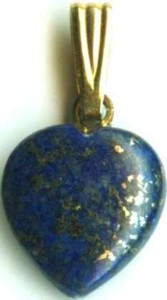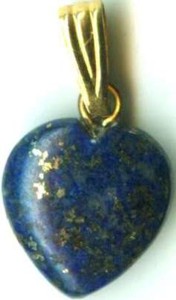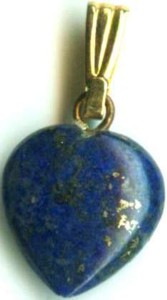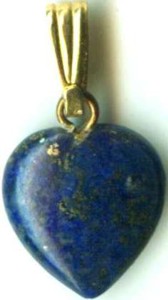|
For Customers outside of USA 
Cute, Petite Hand Carved Lapis Lazuli Semi-Precious Gemstone Heart and Chain from Afghanistan. ORIGIN: Afghanistan; 19th Century; SIZE: Length: 13mm. Width: 12mm. Depth (Thickness): 5mm. Measurements approximate. WEIGHT: 5.95 carats.
NOTES: Chain: Contemporary gold electroplate 60 centimeters (24 inches). A wide variety of other chains are available upon request in sizes from 16 to 30 inches, and in metals ranging from gold and silver electroplate to sterling silver and solid 14kt gold. The default chain (absent contrary instructions) is gold electroplate, 24 inches. We also have available handcrafted Greek black leather cords. DETAIL: A gorgeous, richly colored natural dark blue lapis lazuli semi-precious gemstone from the 7,000 year old mines at Badakhshan in Afghanistan, source of lapis lazuli for the ancient Egyptians, Sumerians, Phoenicians, and the rest of the ancient world, who referred to lapis lazuli as the gemstone of the heavens, as the golden-flecks of sparkling iron pyrite in the deep blue body was often associated by the ancients with the stars in the heavens. Here's a very cute hand-crafted semi-precious lapis lazuli gemstone heart, produced from material mined in the late 1940's or early 1950's in Afghanistan. The gemstone was the hand shaped, hand polished, and hand drilled in India, most likely in Bombay, one of the principal gemstone finishing centers in the world. Originally produced for export to England, they ended up collecting dust in a warehouse. The semi-precious lapis lazuli gemstone is very nice quality, and possesses a very beautiful sprinkling of golden colored flecks of iron pyrite. The gemstone pendant includes the 24 inch gold electroplated chain depicted above at no additional charge. We also have available sterling silver and solid 14kt gold chains as well. For over 6,000 years, through the ancient civilizations of ancient Sumeria and Babylon, through ancient Greece, the Roman Empire, and into contemporary times, the beautiful golden-flecked dark blue color of lapis lazuli has made it one of the most popular natural gemstones in the history of jewelry.
For more than 7,000 years lapis lazuli has been mined as a gemstone in Afghanistan, near ancient Mesopotamia, and traded throughout the ancient Mediterranean world. Along with turquoise and carnelian, lapis lazuli is undoubtedly amongst the most ancient of gemstones. The most ancient jewelry typically used one or more of these three gemstones (carnelian, turquoise), and lapis lazuli was certainly very popular. The famous mask covering the head of Tutankhamen's mummy is inlaid primarily in lapis lazuli, with accents of turquoise and carnelian. The tombs of both Tutankhamen and Queen Pu-abi of Sumeria, two of the richest tombs in all history, featured lapis lazuli prominently. Archaeological evidence has shown that as long as 5,000 years ago the Egyptians used it in medicines, pigments (ultramarine), cosmetics (eye-shadow) and, of course, jewelry. Besides jewelry, lapis lazuli has also been used since ancient times for mosaics and other inlaid work, carved amulets, vases, and other objects. Most lapis lazuli contains iron pyrite in the form of golden flecks sprinkled throughout the gemstone, the hallmark characteristic of lapis lazuli, often compared by the ancient with stars in the sky.
HISTORY: Lapis Lazuli gets its name from the Arabic word "allazward", meaning "sky-blue". Along with turquoise and carnelian, the three are undoubtedly amongst the most ancient of gemstones. For more than 7,000 years lapis lazuli has been mined as a gemstone in Afghanistan, near ancient Mesopotamia, and traded throughout the ancient Mediterranean world. The ancient source of lapis lazuli was these very same mines at Badakhshan, in the Persian highlands above the fertile Mesopotamian lowlands. The Persian highlands and plateau provided many of the raw materials lacking in the ancient civilizations abounding in the Mesopotamian lowlands (the "fertile crescent"). The most ancient jewelry typically used one or more of these three gemstones (carnelian, turquoise), and lapis lazuli was certainly very popular. How popular? Well, the most ancient examples of jewelry are probably those found in Queen Pu-abi's tomb at Ur in Sumeria dating from the 3rd millennium B.C. In the crypt the queen was covered with a robe of gold, silver, lapis lazuli, carnelian, agate, and chalcedony beads. The lower edge of the robe was decorated with a fringed border of small gold, carnelian, and lapis lazuli cylinders. Near her right arm were three long gold pins with lapis lazuli heads, and three amulets in the shape of fish. Two of the fish amulets were made of gold and the third, you guessed it, lapis lazuli. On the queen's head were three diadems (above, right) each featuring lapis lazuli.
At roughly the same time, lapis lazuli was also certainly popular in 3,100 B.C. with the Egyptians who used it in medicines, pigments (ultramarine), cosmetics (eye-shadow) and, of course, jewelry. The ancient Egyptians believed lapis lazuli to be sacred and used it in the tombs and coffins of pharaohs. The famous mask (left) covering the head of Tutankhamen's mummy is inlaid primarily in lapis lazuli, with accents of turquoise and carnelian. The tombs of Tutankhamen and Queen Pu-abi, two of the richest tombs in all history, lapis lazuli was featured prominently in both.
Besides jewelry, lapis lazuli has also been used since ancient times for mosaics and other inlaid work, carved amulets, vases, and other objects. Ordinarily it was cut cabochon (smooth concave) as a gem. Since ancient times it was also ground and used as a pigment. When lapis was first introduced to Europe, it was called "ultramarinum", which means "beyond the sea". Ground lapis was the secret of the blue in ultramarine, the pigment which painters used to paint the sea and the sky until the nineteenth century. Lapis was also popular in inlays. In what was once one of the cultural capitals of Europe, the columns of St Isaac's Cathedral are lined with lapis, and the Pushkin Palace has lapis lazuli paneling! Most lapis lazuli contains iron pyrite in the form of golden flecks sprinkled throughout the gemstone, the hallmark characteristic of lapis lazuli, often compared by the ancient with stars in the sky.
SHIPPING OPTIONS: All purchases are backed by an unlimited guarantee of satisfaction and authenticity. If for any reason you are not entirely satisfied with your purchase, you may return it for a complete and immediate refund of your entire purchase price. Most of these antique gemstones were originally part of two collections, one originating in India principally composed of gemstones originally mined in India, Burma, Ceylon, and Siam, and then hand faceted in India. The addition of a second accumulation of antique gemstones originally mined in the Urals in the mid to late 19th century (including alexandrite) completed the collection. These gemstones as well were hand finished. The Urals have been one of the world's major sources of precious and semi-precious gemstones for many centuries. As well, additional specimens are occasionally acquired from other institutions and dealers in Eastern Europe and Asia. These antique gemstones are now in the United States and are available for immediate delivery. We ship inventory from the USA order fulfillment center near Seattle, Washington. Your purchase will ordinarily be shipping within 48 hours of payment. A certificate of authenticity is available upon request. We prefer your personal check or money order over any other form of payment - and we will ship immediately upon receipt of your check (no "holds"). We will accept PayPal payments. Please see our "ADDITIONAL TERMS OF SALE".
|
|---|
